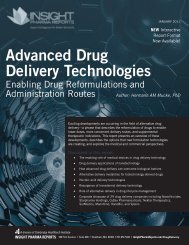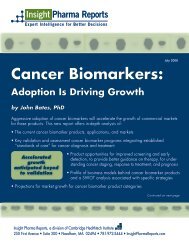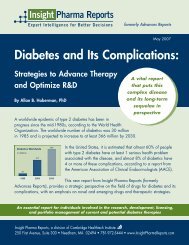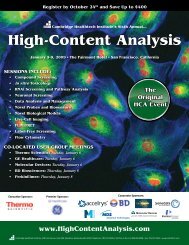2010 Best Practices Competition IT & Informatics HPC
IT Informatics - Cambridge Healthtech Institute
IT Informatics - Cambridge Healthtech Institute
- No tags were found...
Create successful ePaper yourself
Turn your PDF publications into a flip-book with our unique Google optimized e-Paper software.
Published Resources for the Life Sciences<br />
250 First Avenue, Suite 300, Needham, MA 02494 | phone: 781‐972‐5400 | fax: 781‐972‐5425<br />
Technology ROI:<br />
Individual research groups no longer have to over‐spec <strong>IT</strong> solutions to meet peak requirements. By<br />
moving towards centralized solutions, there are substantial gains thanks to the coordination of<br />
staff, computer halls, etc.<br />
Research ROI:<br />
An example research project, that leveraged UPPNEX, has reduced its time‐to‐completion by several<br />
months . The project focused on gaining a deeper understanding of the relationship between<br />
genetic variation and phenotypic variation. Through whole genome resequencing, the researchers<br />
distinguished key genes causing the differences between wild and domestic chickens. They have<br />
identified candidate mutations that cause special effects on the phenotype. This is an efficient<br />
strategy to increase our understanding of how different genes control different traits.<br />
One gene, associated with the fast growth of broiler chickens, is associated with obesity in humans.<br />
The study established a new animal model that can be used to explore the mechanics of how this<br />
gene influences human growth and obesity.<br />
Lastly, the domestic chicken is the most important global source of animal protein. The research has<br />
established the possibility to develop domestic chickens that are extremely efficient producers of<br />
animal proteins, namely eggs and meat.<br />
E. CONCLUSIONS/implications for the field.<br />
The recent technological advancements, affordability and wide deployment of NGS machines is<br />
feeding a tsunami of digital data. The information technology infrastructure required to compute<br />
and store such vast amounts of data is beyond the funding of Individual research groups.<br />
Centralized <strong>HPC</strong> and data‐storage facilities are being deployed at regional, national and global level<br />
to provide researchers with access to the <strong>IT</strong> infrastructure they require.<br />
The challenge for the centralized facilities is to provide sufficient compute and data‐storage<br />
resources to fuel multiple research projects simultaneously. With ever‐increasing amounts of<br />
digital data being ingested, how do they process, manage and store the data both reliably and<br />
efficiently.<br />
Traditional storage technologies cannot keep pace. Their limitations on capacity encourage data<br />
silos, multiple copies of data, system administration headaches and an escalating management<br />
overhead. Clustered storage technologies struggle to address diverse performance requirements<br />
within the life sciences workflow, again encouraging data silos and disparate storage management<br />
layers.








